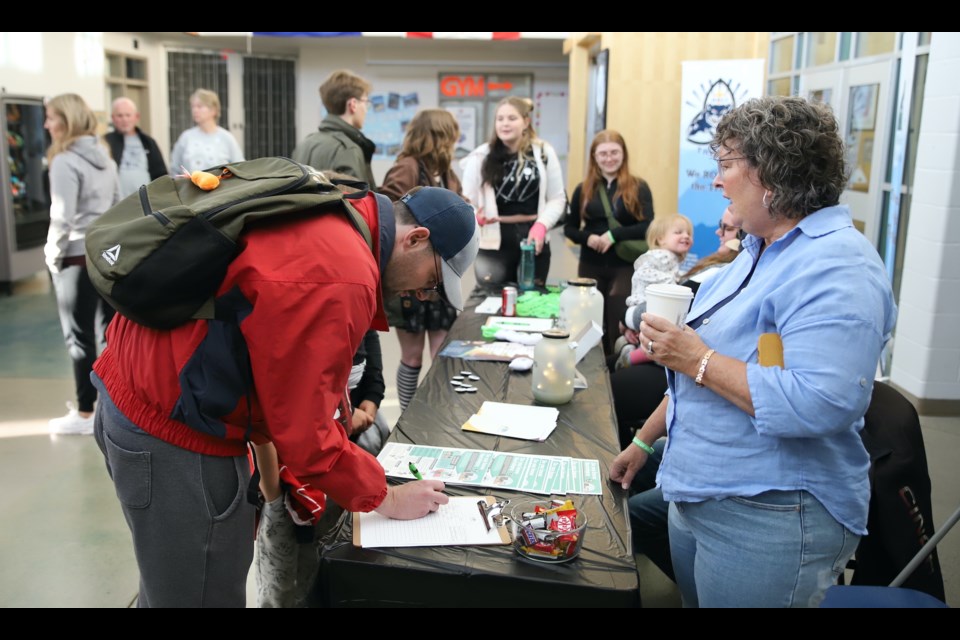OLDS — Local residents Dana and Dan Overwater’s daughter Rosa was just recently diagnosed with type 1 narcolepsy.
It’s a rather rare condition in which those patients don’t get proper sleep and are thus prone to sleep at inopportune times – even fall down suddenly.
To help Rosa and others who may suffer from the condition, Dana hopes to start a narcolepsy support group; possibly the first in Alberta and the country, she believes.
To that end the Overwaters and others organized a Night Walk for Narcolepsy, held Sept. 21 at Holy Trinity Catholic School. It raised $886.35 for sleep disorder awareness. Plans are already afoot to hold another one next year.
Several dozen people attended, including many supportive friends and family members.
Dana noted that Sunday, Sept. 22 was World Narcolepsy Day.
“That’s why we chose today because nobody wants to go out on a Sunday night,” she said with a laugh.
Before the walk, talks on narcolepsy were given in the gym by a woman diagnosed with narcolepsy and the mother of son diagnosed with the condition.
It was noted that many people joke about narcolepsy, but it’s serious issue; life-changing for those afflicted with it.
Narcolepsy is a lifelong disorder – there is currently no cure.
There are medications that can be taken to help people manage it, however, there are side effects with those meds.
Also, it can take trial and error to find which medications work, because different patients respond differently to them.
Statistically, one in every 2,000 people are said to suffer from narcolepsy, but it’s believed that far more may be afflicted, because those are just the people who have been diagnosed with it. In fact, estimates are that as many as 50 per cent may remain undiagnosed.
It can take many, many years to obtain the diagnosis because the symptoms are similar to other problems like depression.
According to a handout from Wake Up Narcolepsy Inc., an American support organization, even some sleep specialists can have difficulty diagnosing it.
The handout says “only 42 per cent of sleep specialists and nine per cent of clinical doctors feel comfortable diagnosing narcolepsy.”
It says “only 22 per cent of sleep specialists are able to identify the five key symptoms of narcolepsy. As a result, it can take two to 10 years to diagnose narcolepsy.”
The handout further says “64 per cent of children and adolescents with narcolepsy are originally misdiagnosed.”
The Albertan interviewed Dan Overwater about Rosa’s diagnosis, how it came about.
Dan said Rosa, 18, the fifth of six kids, was often tired as a young girl.
“She slept well as a kid, hard to get her to do jobs, but she would be on task and could handle it,” he said.
When she got into her teens, Rosa became noticeably lethargic, but it was hard to determine whether that was due to some kind of condition or just part of being a teenager.
“It was kind of like a teenager rebellious kind of thing and it fit right in with how some teens go for that era or age,” Dan said.
The condition began to affect Rosa’s marks in school, but still doctors couldn’t find anything wrong with her.
Finally, about two years ago, the issue became too much for Rosa and she underwent a mental health crisis and ended up in the Children’s Hospital in Calgary.
One or two specialists there thought she might be suffering from narcolepsy, but they weren’t sure.
At the advice of a family member, the Overwaters took Rosa to a private clinic in Edmonton where finally, this spring, the diagnosis was made after some sleeping tests which Dan said she passed the “with flying colours.”
Now that that diagnosis has been made, life is getting better for Rosa, although it’s still not easy.
Because she is a type 1 narcoleptic, Rosa can be hit with cataplexy, a brief, but sudden loss of muscle tone that can cause anything from slurring of speech to total collapse and an inability to talk or move.
“It comes on and it’s just so fast, they lock up and end up falling asleep, either behind the wheel of a vehicle, walking down the stairs,” Dan said.
As a result, type 1 narcoleptics are often unable to obtain and/or keep a driver’s licence.
“As a teenager, this is devastating, as it’s one of the things they look forward to doing in the future,” the crowd was told.
With help from a school in Red Deer, Rosa graduated from high school last year.
Dan was asked if Rosa can take post-secondary education.
He said she’s currently upgrading her math and may take some other classes at home while also trying to figure out which medications work best for her.
“We figured it would be better for her to work on some of her medication to get a routine before she tries to put herself through that stress,” he said.
Although there’s currently no cure for narcolepsy, Dan is hopeful that might change.
He said research into the disease is “moving ahead a lot faster in the last few years.”
After the talks were over, many members of the crowd took part in the Night Walk for Narcolepsy which began from the school.
Signs along the path, lit up with tiny lights and anchored by colourful milk jugs imparted facts regarding narcolepsy.



